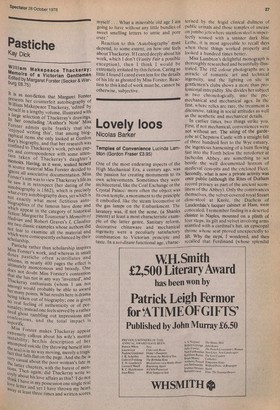Lovely loos
Nicolas Barker
Temples of Convenience Lucinda Lambton (Gordon Fraser £3.96) One of the most endearing aspects of the High Mechanical Era, a century ago, was the passion for creating monuments to its own achievements. Sometimes they were architectural, like the Coal Exchange or the Crystal Palace: more often the object was its own temple, a monument to the principle it embodied, like the steam locomotive or the gas tamps on the Embankment. The lavatory was, if not the acme, (a Shanks patent) at least a most characteristic example of the latter genre. Sanitary reform, decorative chinaware and mechanical ingenuity were a peculiarly satisfactory combination to Victorian principle and taste. In a soi-disant functional age, charac tensed by the frigid clinical dullness of public urinals and those temples of unease on jumbo jets where stainless steel is imperfectly soused with a sinister dark blue Lethe, it is most agreeable to recall days when these things worked properly and looked a hundred times better.
Miss Lambton's delightful monograph is thoroughly researched and beautifully illustrated. The 102 colour photographs are a miracle of romantic art and technical ingenuity, and the lighting on site in gentlemen's clubs shows a more than professional intrepidity. She divides her subject in two chronologically, into the premechanical and mechanical ages. In the first, where relics are rare, the treatment is discursive, taking in social attitudes as well as the aesthetic and mechanical details.
In earlier times, two things strike you. First, if not mechanical, conveniences were not without art. The siting of the garderobe at Chepstow Castle with a straight fall of three hundred feet to the Wye estuary, the ingenious harnessing of a burn flowing fast into the Forth below the reredorter at Inchcolm Abbey, are something to set beside the well documented horrors of medieval cess-pits and the enclosed Fleet. Secondly, what is now a private activity was once public (although the Rites of Durham record privacy as part of the ancient seemliness of the Abbey). Only the contrivances themselves, the velvet-covered royal Stuart close-stool at Knole, the Duchess of Lauderdale's lacquer cabinet at Ham, were concealed. I remember finding in a deserted cloister in Naples, mounted on a plinth of four steps, its gilt and velvet involving arms mantled with a cardinal's hat, an episcopal throne whose seat proved unexpectedly to lift. Why the steps, I wondered, and then recalled that Ferdinand (whose splendid ugliness is immortalised by Goya) used to hold a literally privy council of his intimate friends.
The water closet is a British achievement. Sir John Harrington, Queen Elizabeth's godson, celebrated his invention with' the worst pun in the language, The Metamorphosis of Ajax. (His godmother's hygiene — remember the bath 'whether she needed it or no' — was a matter of concern to her subjects, and when she visited Queen's College, the fellows recorded in their minute book that they were obliged to borrow from King's College, having none themselves, a silver chamber pot for her use). But it was two hundred years before Joseph Bramah perfected the S-trap which made the modern WC possible. Miss Lambton's most beautiful photographs recall the achievements of the next century, the magnificent fittings by Shanks at Kinloch Castle on the Island of Rum, the lavatory places in Wales built for the Marquess of Bute by William Burges (whose own beautiful washstand was given by Sir John Betjeman to Evelyn Waugh ).
The Doulton fittings at the Manchester Reform Club, Twyford's hexagonal pedestal at Rothesay Harbour, the great ceramic arches in the underground gents at Derby Square, Liverpool, which actually support a vast memorial to Queen Victoria above, are among the great monuments of their age. Miss Lambton is, alas, too late to record those of the United Services Club which had, at a convenient height above the ground, a head of the mourning Queen in terracotta transfer with concentric rings round it. Did the major generals never consider after lunch the penalty for lesemajeste? At a more domestic level, the decorations, floral, classical and marine, in colour blue-and-white and relief, on many still surviving bowls, show the pride which the Victorians took in the new invention. Their names, Tubal, Sultan, Excelsior, Waterfall, Deluge, Unitas, Simplicitas, reveal an equal pride, summed up by The Closet of the Century' of George Jennings, inventor of the original 'Monkey Closets' at the Great Exhibition, who deserves to be remembered as the founder of the industry.
Miss Lambton ends with a plea for the return of 'a rich, delightful form' to such 'an intimate friend to us all'. She would have been echoed by the Dean of Carlisle whom my father visited early in this cehtury. There he found by the mahogany throne a single book, a specially bound copy of those parts only of the cathedral statutes that dealt with the powers of the dean over the canons. First things, the dean told my father, first.







































 Previous page
Previous page